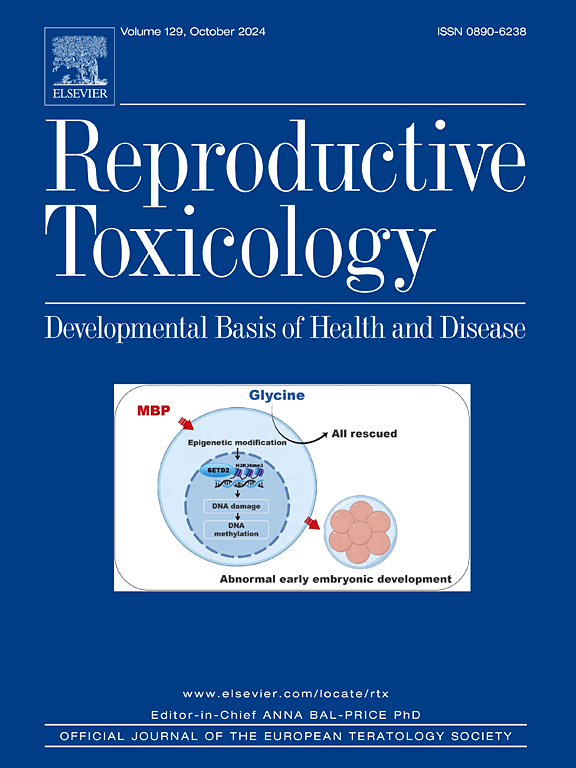兔乳腺的整装制备和分析。
IF 3.3
4区 医学
Q2 REPRODUCTIVE BIOLOGY
引用次数: 0
摘要
乳腺的结构和组成在人的一生中会发生动态变化,主要受激素波动和环境因素的影响。从胚胎发育到更年期,乳腺组织要适应产后扩张、妊娠引起的泌乳和断奶后内陷等阶段。激素、生长因子、细胞因子和外源性因子调节这些先天性过程,影响乳腺上皮细胞的增殖和敏感性,尤其是极易受内分泌干扰的末端末芽(TEB)和小叶。啮齿类动物模型为乳腺生物学提供了宝贵的见解,但与人类发育相比仍存在差异,这促使人们探索兔子等替代模型。此外,在安全性评估中不再使用非人类灵长类动物的趋势也在不断发展,因此更需要针对兔子模型中所有组织的评估工具。兔乳腺与人类相似,因此很有希望用于研究乳腺生物学和病理学。然而,与啮齿类动物乳腺相比,兔乳腺组织更厚,技术难度更大,因此缺乏对兔乳腺进行整装分析的方案。在这里,我们开发了一种从啮齿类动物研究中修改而来的方法,用于制备和分析兔乳腺全装片,这对于推进乳腺生物学研究以及了解激素和毒物引起的乳腺生长和功能紊乱的影响至关重要。本文章由计算机程序翻译,如有差异,请以英文原文为准。
Whole mount preparation and analysis of rabbit mammary gland
The mammary gland undergoes dynamic structural and compositional changes throughout life, influenced significantly by hormonal fluctuations and environmental factors. From embryonic development through menopause, this tissue adapts to accommodate phases such as postnatal expansion, pregnancy-induced lactation, and post-weaning involution. Hormones, growth factors, cytokines, and exogenous factors regulate these innate processes, affecting mammary epithelial cell proliferation and sensitivity, particularly in terminal end buds (TEB) and lobules, which are highly susceptible to endocrine disruption. Rodent models have provided invaluable insights into mammary gland biology, yet differences exist compared to human development, prompting the exploration of alternative models like rabbits. Additionally, there is momentum to move away from the use of nonhuman primates in safety assessments, increasing the need for evaluation tools for all tissues in the rabbit model. Rabbit mammary glands exhibit similarities to humans, making them promising for studying breast biology and pathology. However, protocols for whole-mount analysis of rabbit mammary glands are lacking due to the technical challenges of working with thicker tissue than rodent mammary glands. Here, we developed a methodology modified from rodent studies for preparing and analyzing rabbit mammary gland whole mounts, which is essential for advancing research in mammary gland biology and understanding the effects of hormonal and toxicant-induced disruption of mammary gland growth and function.
求助全文
通过发布文献求助,成功后即可免费获取论文全文。
去求助
来源期刊

Reproductive toxicology
生物-毒理学
CiteScore
6.50
自引率
3.00%
发文量
131
审稿时长
45 days
期刊介绍:
Drawing from a large number of disciplines, Reproductive Toxicology publishes timely, original research on the influence of chemical and physical agents on reproduction. Written by and for obstetricians, pediatricians, embryologists, teratologists, geneticists, toxicologists, andrologists, and others interested in detecting potential reproductive hazards, the journal is a forum for communication among researchers and practitioners. Articles focus on the application of in vitro, animal and clinical research to the practice of clinical medicine.
All aspects of reproduction are within the scope of Reproductive Toxicology, including the formation and maturation of male and female gametes, sexual function, the events surrounding the fusion of gametes and the development of the fertilized ovum, nourishment and transport of the conceptus within the genital tract, implantation, embryogenesis, intrauterine growth, placentation and placental function, parturition, lactation and neonatal survival. Adverse reproductive effects in males will be considered as significant as adverse effects occurring in females. To provide a balanced presentation of approaches, equal emphasis will be given to clinical and animal or in vitro work. Typical end points that will be studied by contributors include infertility, sexual dysfunction, spontaneous abortion, malformations, abnormal histogenesis, stillbirth, intrauterine growth retardation, prematurity, behavioral abnormalities, and perinatal mortality.
 求助内容:
求助内容: 应助结果提醒方式:
应助结果提醒方式:


